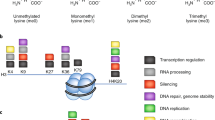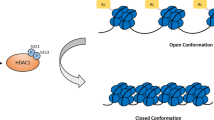Abstract.
Differential acetylation of histones and transcription factors plays an important regulatory role in developmental processes, proliferation and differentiation. Aberrant acetylation or deacetylation leads to such diverse disorders as leukemia, epithelial cancers, fragile X syndrome and Rubinstein-Taybi syndrome. The various groups of histone acetyltransferases (CBP/p300, GNAT, MYST, nuclear receptor coactivators and TAFII250) and histone deacetylases are surveyed with regard to their possible or known involvement in cancer progression and human developmental disorders. Current treatment strategies are discussed, which are still mostly limited to histone deacetylase inhibitors such as trichostatin A and butyrate.
Similar content being viewed by others
Author information
Authors and Affiliations
Additional information
Rights and permissions
About this article
Cite this article
Timmermann, S., Lehrmann, H., Polesskaya, A. et al. Histone acetylation and disease. CMLS, Cell. Mol. Life Sci. 58, 728–736 (2001). https://doi.org/10.1007/PL00000896
Issue Date:
DOI: https://doi.org/10.1007/PL00000896




